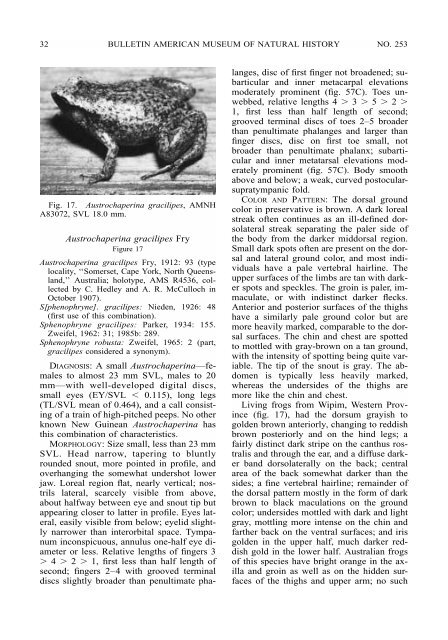SPHENOPHRYNE - American Museum of Natural History
SPHENOPHRYNE - American Museum of Natural History
SPHENOPHRYNE - American Museum of Natural History
Create successful ePaper yourself
Turn your PDF publications into a flip-book with our unique Google optimized e-Paper software.
32 BULLETIN AMERICAN MUSEUM OF NATURAL HISTORY NO. 253<br />
Fig. 17. Austrochaperina gracilipes, AMNH<br />
A83072, SVL 18.0 mm.<br />
Austrochaperina gracilipes Fry<br />
Figure 17<br />
Austrochaperina gracilipes Fry, 1912: 93 (type<br />
locality, ‘‘Somerset, Cape York, North Queensland,’’<br />
Australia; holotype, AMS R4536, collected<br />
by C. Hedley and A. R. McCulloch in<br />
October 1907).<br />
S[phenophryne]. gracilipes: Nieden, 1926: 48<br />
(first use <strong>of</strong> this combination).<br />
Sphenophryne gracilipes: Parker, 1934: 155.<br />
Zweifel, 1962: 31; 1985b: 289.<br />
Sphenophryne robusta: Zweifel, 1965: 2 (part,<br />
gracilipes considered a synonym).<br />
DIAGNOSIS: A small Austrochaperina—females<br />
to almost 23 mm SVL, males to 20<br />
mm—with well-developed digital discs,<br />
small eyes (EY/SVL 0.115), long legs<br />
(TL/SVL mean <strong>of</strong> 0.464), and a call consisting<br />
<strong>of</strong> a train <strong>of</strong> high-pitched peeps. No other<br />
known New Guinean Austrochaperina has<br />
this combination <strong>of</strong> characteristics.<br />
MORPHOLOGY: Size small, less than 23 mm<br />
SVL. Head narrow, tapering to bluntly<br />
rounded snout, more pointed in pr<strong>of</strong>ile, and<br />
overhanging the somewhat undershot lower<br />
jaw. Loreal region flat, nearly vertical; nostrils<br />
lateral, scarcely visible from above,<br />
about halfway between eye and snout tip but<br />
appearing closer to latter in pr<strong>of</strong>ile. Eyes lateral,<br />
easily visible from below; eyelid slightly<br />
narrower than interorbital space. Tympanum<br />
inconspicuous, annulus one-half eye diameter<br />
or less. Relative lengths <strong>of</strong> fingers 3<br />
4 2 1, first less than half length <strong>of</strong><br />
second; fingers 2–4 with grooved terminal<br />
discs slightly broader than penultimate pha-<br />
langes, disc <strong>of</strong> first finger not broadened; subarticular<br />
and inner metacarpal elevations<br />
moderately prominent (fig. 57C). Toes unwebbed,<br />
relative lengths 4 3 5 2 <br />
1, first less than half length <strong>of</strong> second;<br />
grooved terminal discs <strong>of</strong> toes 2–5 broader<br />
than penultimate phalanges and larger than<br />
finger discs, disc on first toe small, not<br />
broader than penultimate phalanx; subarticular<br />
and inner metatarsal elevations moderately<br />
prominent (fig. 57C). Body smooth<br />
above and below; a weak, curved postocularsupratympanic<br />
fold.<br />
COLOR AND PATTERN: The dorsal ground<br />
color in preservative is brown. A dark loreal<br />
streak <strong>of</strong>ten continues as an ill-defined dorsolateral<br />
streak separating the paler side <strong>of</strong><br />
the body from the darker middorsal region.<br />
Small dark spots <strong>of</strong>ten are present on the dorsal<br />
and lateral ground color, and most individuals<br />
have a pale vertebral hairline. The<br />
upper surfaces <strong>of</strong> the limbs are tan with darker<br />
spots and speckles. The groin is paler, immaculate,<br />
or with indistinct darker flecks.<br />
Anterior and posterior surfaces <strong>of</strong> the thighs<br />
have a similarly pale ground color but are<br />
more heavily marked, comparable to the dorsal<br />
surfaces. The chin and chest are spotted<br />
to mottled with gray-brown on a tan ground,<br />
with the intensity <strong>of</strong> spotting being quite variable.<br />
The tip <strong>of</strong> the snout is gray. The abdomen<br />
is typically less heavily marked,<br />
whereas the undersides <strong>of</strong> the thighs are<br />
more like the chin and chest.<br />
Living frogs from Wipim, Western Province<br />
(fig. 17), had the dorsum grayish to<br />
golden brown anteriorly, changing to reddish<br />
brown posteriorly and on the hind legs; a<br />
fairly distinct dark stripe on the canthus rostralis<br />
and through the ear, and a diffuse darker<br />
band dorsolaterally on the back; central<br />
area <strong>of</strong> the back somewhat darker than the<br />
sides; a fine vertebral hairline; remainder <strong>of</strong><br />
the dorsal pattern mostly in the form <strong>of</strong> dark<br />
brown to black maculations on the ground<br />
color; undersides mottled with dark and light<br />
gray, mottling more intense on the chin and<br />
farther back on the ventral surfaces; and iris<br />
golden in the upper half, much darker reddish<br />
gold in the lower half. Australian frogs<br />
<strong>of</strong> this species have bright orange in the axilla<br />
and groin as well as on the hidden surfaces<br />
<strong>of</strong> the thighs and upper arm; no such
















